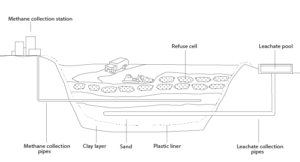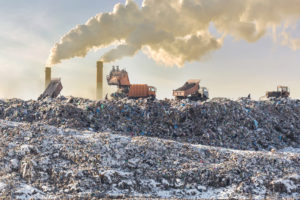Read the Following Selection
Read the following selection, or click on the play button below to listen aloud.
What Is a Landfill?
A landfill is a place where garbage is buried. Some landfills are holes in the ground, and some are hills of garbage on top of the ground. The diagram below shows a landfill built in a hole in the ground.

Each day, trucks dump loads of garbage in the landfill. At the end of each day, all the garbage from the day is covered with a layer of dirt. One day’s garbage covered with dirt is called a refuse cell. (Refuse, which is another word for garbage, is pronounced like this: ref-yooz).
When it rains on a landfill, the rainwater seeps down through all the garbage. Rainwater that seeps through a landfill is called leachate. It is important to keep the leachate from seeping into the soil under the landfill. There might be dangerous chemicals in the landfill that go into the leachate. The leachate can pollute the soil, and it can also pollute water that is underground. Then the polluted underground water might end up in a well that someone uses to get drinking water. The polluted water might also go into a lake or river that provides a community with drinking water.
Dealing with Leachate
Most landfills have three features to keep leachate from mixing with soil and water under the landfill:
Leachate collection pipes: Directly under the bottom of the landfill are pipes that are surrounded by a layer of sand. There are many small holes in the pipes. Leachate flows through the sand and collects in the pipes. The leachate then flows into pipes that do not have holes. These pipes carry the leachate to a place where any dangerous chemicals can be removed.
Plastic liner: Under the leachate collection pipes and sand, there is a plastic liner. This liner prevents leachate from seeping down into the soil.
Clay barrier: It is possible that the plastic liner might develop a hole that allows leachate to leak through. The clay barrier provides an extra layer of protection. Clay can absorb and hold onto a lot of water. If some leachate does leak through the liner, the clay barrier keeps the leachate from seeping down into the soil under the landfill.
Once a landfill can hold no more garbage, it is covered over with dirt. Then grass and trees are planted on top. Some landfills become parks or sports fields.

The Problem with Landfills
A city produces large amounts of garbage year after year. Most landfills take up a lot of land so they can hold a lot of garbage. Once a landfill can hold no more garbage, a new landfill must be created. Many communities are running out of space for new landfills. A community might need empty land for building new houses or factories, or for farmland.
Landfills are one reason why recycling is important. When people recycle, less of their garbage ends up in landfills. Then fewer landfills are needed.
Fun Facts
• The average North American will throw away 600 times their adult weight in garbage in their lifetime. This means a 68 kg adult will throw away 40,800 kg of garbage during their life.
• It costs more than $1.5 billion each year across Canada to dispose of garbage.
• It takes 10 plastic pop bottles to make the warm lining for one ski jacket.
• There are more than 10,000 landfill sites across Canada.
• 450 g of newspaper can be recycled to make 6 egg cartons, 6 cereal boxes, or 2000 sheets of paper.
• 70% of the garbage in landfill sites could be reused or recycled.
Now, show what you know!
Complete some questions about the reading selection by clicking “Begin Questions” below.









